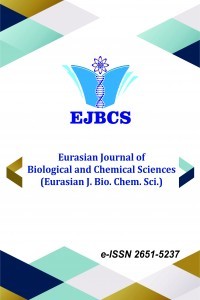Method Validation for The Determination of Toxic Elements in Fizzy Fruity Mineral Water Drinks Using ICP-MS
Method Validation for The Determination of Toxic Elements in Fizzy Fruity Mineral Water Drinks Using ICP-MS
Fizzy fruity mineral water Health risk, ICP-MS,
___
- Arif TJ, Mudsser A, Kehkashan S, Arif A, Inho C, Qazi M and Rizwanul H 2015. Heavy Metals and Human Health: Mechanistic Insight into Toxicity and Counter Defense System of Antioxidants. Int. J. Mol. Sci., 16: 29592-29630.
- Astel A, Michalski R, Lyko A, Czapla MJ, Bigus K, Szopa S and Kwiecinska A 2014 Characterization of bottled mineral waters marketed in Poland using hierarchical cluster analysis. Journal of Geochemical Exploration, 143: 136-145.
- Baba A, Ereeş FS, Hıçsönmez Ü, Çam S and Özdılek HG 2008. An assessment of the quality of various bottled mineral water marketed in Turkey. Environmental Monitoring Assessment, 139: 277–285.
- Barbara BAF, Daniel MB and Ricardo JC 2015. Determination of metals in soft drinks packed in different materials by ETAAS. Food Chem, 185:488-494.
- Bertoldi D, Bontempo L, Larcher R, Nicolini G, Voerkelius S, Lorenz GD, Ueckermann H, Froeschl H, Baxter MJ, Hoogewerff J and Brereton P 2011. Survey of the chemical composition of 571 European bottled mineral waters. Journal of Food Composition and Analysis, 24 (3): 376-385.
- EC 1998. COUNCIL DIRECTIVE 98/83/EC of 3 November 1998 on the quality of water intended for human consumption. Official Journal of the European Communities 330: 32.
- EU 2003. EU Directive 2003/40/EC, Establishing the list, concentration limits and labeling requirements for the constitu0065nts of natural mineral waters and the conditions for using ozone-enriched air for the treatment of natural mineral waters and spring waters. Official Journal of the European Communities 126, 34–39 (22.05.2003).
- EU 2014. EUROPEAN UNION (Drinking water) Regulations, S.I. No. 122, 21, available from http://www.irishstatutebook.ie/eli/2014/si/122/made/en/pdfEURACHEM 1998. The Fitness for Purpose of Analytical Methods: A Laboratory Guide to Method Validation and Related Topics. EURACHEM: Uppsala, Sweden, 75 pp. https://www.eurachem.org/images/stories/Guides/pdf/valid.pdf
- FAO/WHO 1997. FAO/WHO Food Consumption and Exposure Assessment of Chemicals. Report of FAO/WHO Consultation WHO, Geneva pp. 17–25.Galadima A and Garba ZN 2012. Heavy metals pollution in Nigeria: causes and consequences. Elixir Pollut., 45: 7917-7922.
- Gutierrez-Reguera F, Montoya-Mayor R, Seijo-Delgado I and Ternero-Rodríguez M 2016. Chemical analysis and nutritional assessment of trace elements in natural mineral waters bottled in Spain. Afinidad, 73 (574): 102-118.
- IARC 2006. Inorganic and organic lead compounds. IARC Monographs on the Evaluation of Carcinogenic Risks to Human 87: 519.
- Kilic S, Yenisoy-Karakas S and Kilic M 2015 Metal contamination in fruit juices in Turkey: Method validation and uncertainty budget. Food Analytical Methods, 8: 2487–2495.
- Kilic S, Cengiz MF and Kilic M 2018a. Monitoring of metallic contaminants in energy drinks using ICP-MS. Environmental Monitoring and Assessment, 190:202.
- Kilic S, Cam İB, Tongur T and Kilic M 2018b. Health risk assessment of exposure to heavy metals and aflatoxins via dietaryi of dried red pepper from marketplaces in Antalya, Southern Turkey. Journal of Food Science, 83(10): 2675-2681.
- Lee HS, Cho YH, Park SO, Kye SH, Kim BH, Hahm TS, Kim M, Lee JO and Kim Cİ 2006. Dietary exposure of the Korean population to arsenic, cadmium, lead and mercury. Journal of Food Composition and Analysis, 19: 31-37.
- Mendil D, Demirci Z, Tuzen M and Soylak M 2010. Seasonal investigation of trace element contents in commercially valuable fish species from the Black sea, Turkey. Food and Chemical Toxicology, 48(3): 865–870.
- Misunda A, Frengstad B, Sewersd U and Reimanna C 1999. Variation of 66 elements in European bottled mineral Waters. The Science of the Total Environment, 243(244): 21-41.
- Tchounwou PB, Yedjou CG, Patlolla AK and Sutton DJ 2012. Heavy metals toxicity and the environment. EXS, 101:133–164. Ubong IU, Obunwo C and Faafa A 2016. Essential and non-essential metals in soft drinks consumed and sold in Port Harcourt, Nigeria. RA J. Appl. Res, 2(8): 550-557.
- WHO 2006. Guidelines for drinking-water quality, First Addendum to third edition. Recommendations, vol. 1 (available on: http://www.who.int/water_sanitation_health/ dwq/gdwq0506.pdf).
- WHO 2009. Chapter 6: Dietary exposure assessment of chemicals in food. Principles and Methods for the Risk Assessment of Chemicals in Food, Environmental Health Criteria.
- WHO 2011. Guidelines for drinking-water quality. World Health Organization, Fourth edition, pp. 564.
- WHO 2003. Antimony in drinking-water – background document for development WHO Guidelines for Drinking-water Quality, Geneva: WHO.
- UNEP/FAO/WHO 1992. Assessment of dietary intake of chemical contaminants. WHO/HPP/FOS/92.6, UNEP/GEMS/92.F2, United Nations Environmental Program, Nairobi.
- USEPA 1989. Risk Assessment Guidance for Superfund Volume I Human Health Evaluation Manual (Part A) Interim Final, vol 1. Office of Emergency and Remedial Response U.S. Environmental Protection Agency Washington, DC. 20450.
- USEPA 2009. United States Environmental Protection Agency, Risk-based concentration table. Philadelphia: United States Environmental Protection Agency, Washington, DC.
- USEPA 2013. Risk based concentration table. Retrieved from https://www.epa.gov.reg3hwmd/risk/human/index.htm
- Yayın Aralığı: Yılda 2 Sayı
- Başlangıç: 2018
- Yayıncı: Muhammet DOĞAN
Deniz ALTUN ÇOLAK, Çağla ERSÖZ
Shadman SADIQ, Saif Talib JASİM, Salar HASAANZADEH, Aymen A. AL-BAYATİ, Asiye Esra EREN, Gülhan TUNÇ
Hakan YILMAZ, Hamdi Güray KUTBAY, Burak SÜRMEN
Exopolysaccharide (EPS) production of halophilic bacteria
Hilal BAŞER, Zehranur YUKSEKDAG
Thermal kinetics and thermodynamics of the dehydration reaction of Mg3(PO4)2·22H2O
Fatma Tuğçe ŞENBERBER, Emek MÖRÖYDOR DERUN
Investigation of Nanoparticle Use in Geopolymer Production
Begüm Seda ÖĞÜN, Emek MÖRÖYDOR DERUN
Betül YILMAZ ÖZTÜRK, Derviş ÖZTÜRK
Van kedilerinde total beyin hacminin bilgisayarlı tomografi görüntüleri kullanılarak hesaplanması
